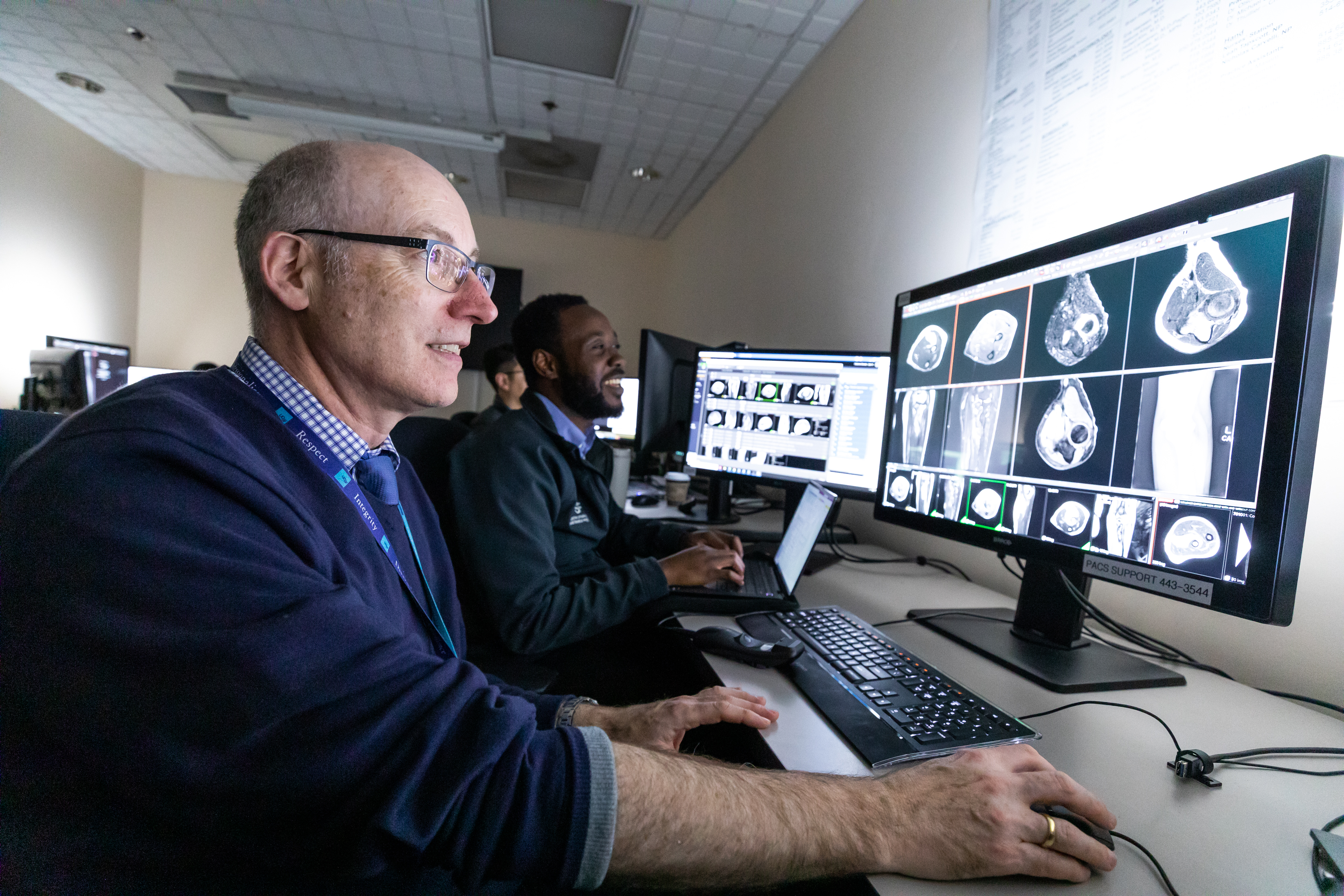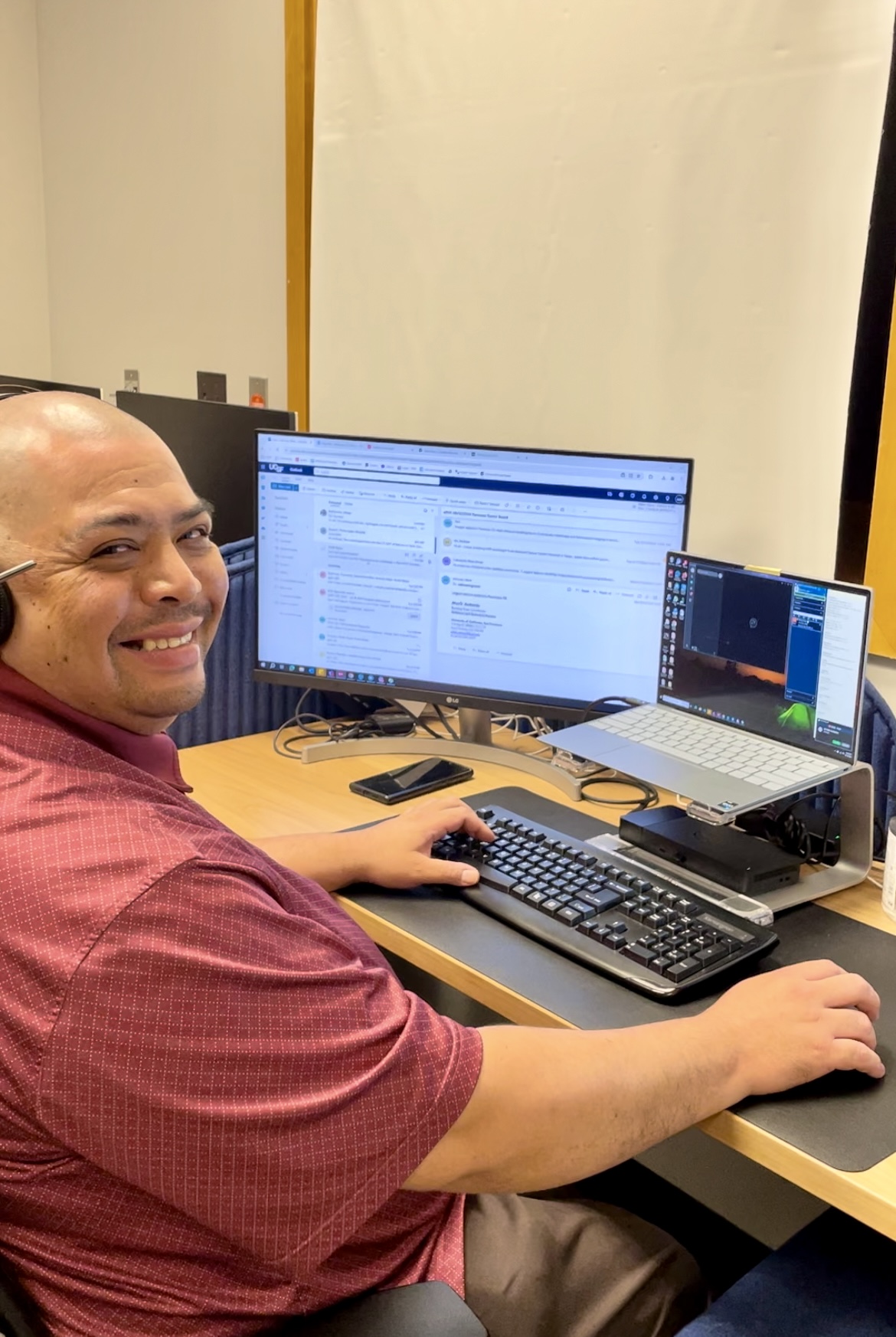On a typical day at the office, reading room practice coordinators Araceli Zavala-Sheridan, Flora Stewart, and Mark Antonio collectively:
- Answer about 150 incoming calls
- Facilitate a handful of urgent outbound calls
- Receive and process several overread requests
Under the guidance of Director of Clinical Affairs Elizabeth Odell and Vice Chair of Clinical Operations and Strategy, Thomas Hope, MD, the new team was established six months ago to handle administrative tasks that contribute to physician burnout while also helping radiologists streamline their workflow with the ultimate goal of ensuring high quality patient care. The new team set up shop in a quiet office, at the end of One Irving Street’s garden pathway. They began fielding incoming calls to the reading rooms and quickly learned to efficiently triage calls and route urgent requests.

Nour Dababo, MD, and Andreas Rauschecker, MD, PhD, in the Neuroradiology reading room at the UCSF Helen Diller Medical Center at Parnassus Heights.
“The Reading Room Practice Coordinators have made a tremendously positive impact on the Neuroradiology reading rooms at our Parnassus and Mission Bay sites,” says Clinical Fellow Nour Dababo, MD. “Their efforts have led to a substantial reduction in the volume of incoming phone calls to the reading room, which has translated to greater uninterrupted time of focus and teaching. And they’re available to help our team connect with referring providers, which saves our team a considerable amount of time and effort.”
As service ramps up, more demand promptly follows. The team kicked off with Abdominal Imaging, Musculoskeletal Imaging, and Neuroradiology reading rooms. Then, they dialed up support to include Cardiothoracic and Molecular Imaging & Therapeutics divisions.
“Araceli, Flora, and Mark have provided excellent support to our section,” says Musculoskeletal Imaging Division Chief Thomas M. Link, MD, PhD. “They have greatly facilitated getting in touch with our providers to communicate urgent findings, something that tremendously improved the efficiency of our service.”

Thomas Link, MD, PhD, Isaac Ghansah, MD, MS, and Kevin Junus, DO, in the MSK reading room at 400 Parnassus Ave.
Robert Flavell, MD, PhD, and Division Chief of Molecular Imaging & Therapeutics, agrees. “Since starting, the interruptions to our workflow have decreased, and the efficiency has improved,” says Flavell. “We greatly appreciate their help.”
The gratitude expressed by the radiologists is deeply felt among this crew. They understand and appreciate the critical role they play in achieving our mission of exceptional patient care.
“We’re incredibly appreciated by the radiologists we work with,” says Zavala-Sheridan, who feels great pride in her work. “My work contributes to timely and accurate diagnoses for patients.”
“What’s most meaningful to me is contributing to radiologists’ workflow so they can focus on patients,” says Stewart, with a similar sense of pride.
A recent tour of the reading rooms provided immediate satisfaction and motivation. “We talk to the radiologists every day, but seeing their workspace gives us more insight to how they work,” says Zavala-Sheridan.

Mark Antonio.
Full of laughs and a good sense of humor, it’s evident that Antonio enjoys strong connections with his colleagues. “We’re a very collaborative team. We like to come together to share our thoughts and come up with good solutions,” he says. “Six months ago we started with three reading rooms. Today we’re up to six reading rooms and our department is growing,” says Antonio, looking toward the future, as he and his team gear up for continued growth.
Later this year, service will expand to include the Pediatric and Breast Imaging reading rooms. Also, plans are underway to continue to enhance administrative support to radiologists through strategic new project development, spearheaded by Odell.
“They are an important new asset to our Neuroradiology division, and we look forward to their continued positive impact on our workflow in the reading room,” adds Dababo.
By Arleen Bandarrae



